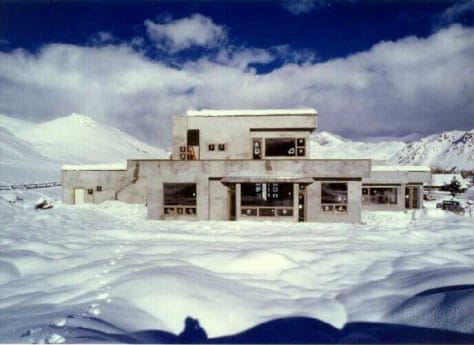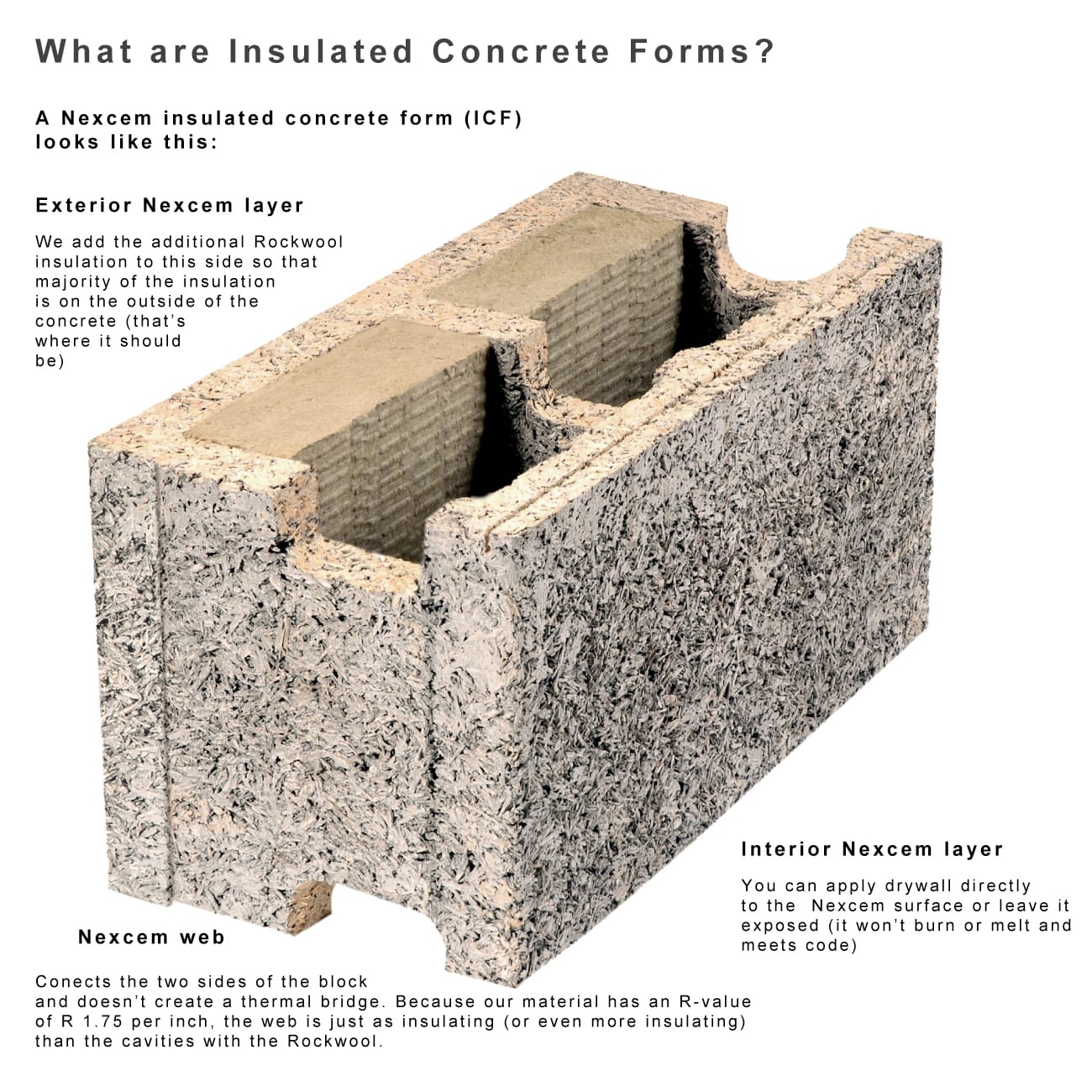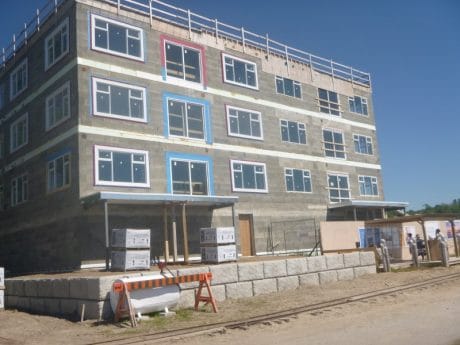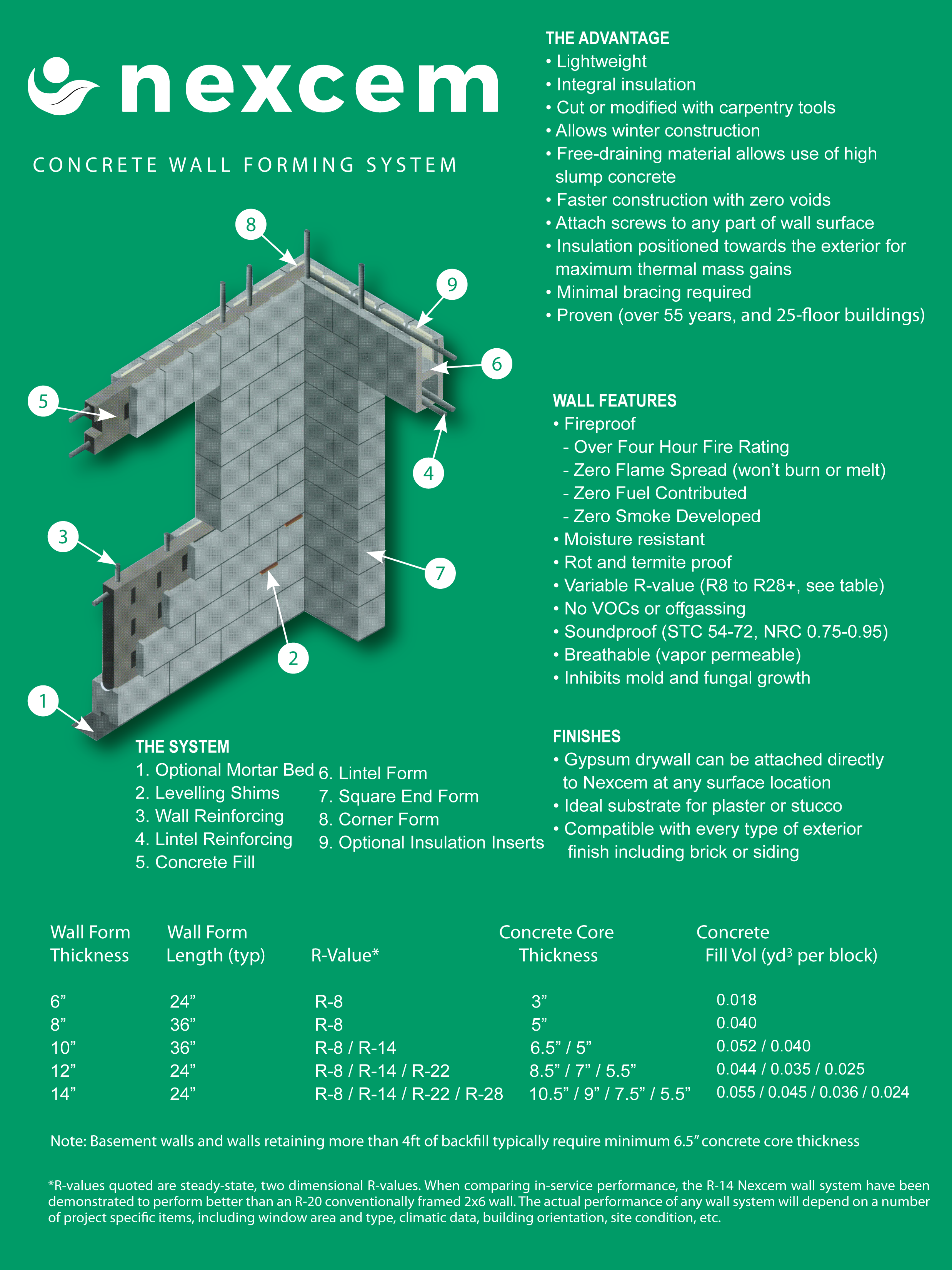Whether you’re a home or building owner or an builder/installer, there are pros and cons of insulated concrete forms (ICFs), just like any other building material out there. And while ICFs are on the rise (especially as the advantages over wood-framed homes come to light), it’s still important to take a balanced look, and recognize that what is best for the homeowner isn’t always what is best for builder.
Pros And Cons of ICFs for Home/Building Owners
Home and building owners benefit from a number of additional advantages:

- Energy Efficiency
Homeowners benefit from enhanced energy efficiency — the specific energy efficiency for any given home depends on a number of site specific considerations:
- Building orientation
- South Facing window/door area
- Passive solar design taken into consideration (overhangs)
- Insulation in the roof
- Window and door insulation
- Quality of construction (air tight)
Typically, the average ICF home requires about 34% less energy to cool and 46% less energy to heat. When you translate this into an “effective” R-value, it works out to between R-20 and R-28. The problem with wood-frame homes is that they have insulation gaps and thermal bridging, resulting in energy loss. ICFs are so airtight that leaks simply don’t occur. In fact, this study found that an ICF wall had 60% less energy loss than a wood-framed wall.
Another major advantage of ICFs is their thermal mass, absorbing heat during the day and then circulating the energy back into the house as temperature drops at night. This results in a much more stable (and comfortable) temperature throughout the home.
- Extremely Resistant To High Winds And Climactic Events
Next to their energy efficiency, ICF homes are extremely durable due to the strength of the concrete. This is why there’s an increasing number of homeowners who are choosing to build with ICFs in hurricane-prone areas. In fact, ICF homes are entirely disaster-resilient and have a 4-hour fire rating. With non-styrofoam systems like Nexcem, you have the added benefit of an exterior surface that won’t dent and is impact-proof as well as a surface that won’t burn or melt like other traditional ICF systems.
 As proof of their durability, a laboratory study conducted by the Wind Science and Engineering Research Center at Texas Tech University found that ICF walls were “far superior” to both conventional wood and steel framed walls in conditions simulating a tornado.
As proof of their durability, a laboratory study conducted by the Wind Science and Engineering Research Center at Texas Tech University found that ICF walls were “far superior” to both conventional wood and steel framed walls in conditions simulating a tornado.
- A Quiet Home
The combination of the Nexcem and the concrete, which acts as a sound barrier, results in a very quiet home. Nexcem ICFs, for instance, have a minimum sound transmission class of 56, which is twice as much as a standard wood-framed wall. Our wall systems have been tested to STC levels of 72, which is impossible with conventional construction
That’s exactly why the Edinburgh Condominiums in Port Elgin (shown below) were built with Nexcem ICFs .

The effect? Almost no outdoor sounds and a quiet, comfortable home.
- Mold and Mildew Resistant
Finally, ICF homes are also mold and mildew resistant. The Nexcem material has the ability to regulate humidty levels – something that is not possible with styrofoam. See here for more detailed explanation. Basically just like the concrete core has thermal mass and can store and release energy, the Nexcem material has “hygric” mass which means it can store and release moisture. We’re not talking about liquid water, but just the ability to regulate humidity and act as a buffer when there are large swings in moisture content in the air.
In contrast, a traditional build with house wrap results in a build-up of moisture. Nexcem allow walls to breathe and prevent mold and mildew from growing.
And as for the cons…
- A Possible Lack of ICF-Friendly Builders, Architects and Engineers
Depending on where you are building there is can be a lack of builders, architects and engineers who specialize in ICFs, which can make them reluctant to want to choose ICFs due to their lack of experience. Typically, builders don’t like change and want to do what they are used to doing. However, this will continue to change as ICFs continue to become more and more popular.
Here is a Nexcem friendly builders list to locate installers who have worked with ICFs.
- ICF Walls Are Thicker = Reduced Overall Interior Space Dimensions)
ICF walls are thicker; and while this creates a very desirable window well effect, it also can reduce the overall interior space dimensions as well.
- Slighter Higher Upfront Costs
The initial cost of ICFs can sometimes be slightly higher than framed construction, but with an experienced ICF builder, and depending on the nature of the structure being built, this isn’t necessarily the case. Additionally, when it comes to cost, an air exchange system in an air tight ICF home isn’t optional.
- Future Additions Can Be Challenging
Finally, future additions and/or renovations can be a little more challenging with steel-reinforced concrete walls as compared to wood-framed buildings.
Pros And Cons for Installers
Installers benefit from:
- Ease of Construction
First and foremost, installers benefit from a much easier build compared to wood. This is true even in winter conditions. Construction steps are condensed into just six simple steps, eliminating steps like house wrap. Put another way, many different building components are rolled into one product. The blocks then stack together like lego.

ICFs typically require less trades and therefore less coordination of trades, which always results in less mistakes.
- Versatility and Flexibility in Construction
An easy build results in a much more efficient build as well.
Again, part of the ease comes from the fact that only one trade is needed as well as the fact that you don’t need to sub out the basement (and the fact that callbacks are greatly reduced).
Even in winter conditions, you don’t need to install exterior cladding; once the building is enclosed, interior work can be done.
Once the building is ready to be inspected by the building official, installers will also see fewer inspections as there framing and insulation inspections are eliminated.
And as for the cons…
- More Advanced Planning Is Needed
More advanced planning is needed at a couple of different stages of the ICF build. For instance, in order to determine lintel requirements, you must first determine loads.
Similarly, post concrete pour changes and service penetration locations can be difficult without the right equipment on hand, so advanced planning is recommended.
- A Possible Lack of ICF-Friendly sub-contractors
While ICFs are growing in popularity, in some areas there can still be a lack of ICF-friendly installers (as well as electricians, plumbers, HVAC companies, framers and local building officials with ICF knowledge).
- Certain Practices Must be Adhered To
With ICFs, certain practices must be adhered to. Here are three primary examples:
- Proper concrete consolidation practices (due to the fact that voids in ICF walls are not obvious and visible). Some systems like Nexcem are more forgiving as it is porous and naturally de-waters concrete. The porosity means that air can’t get trapped and there is no potential for voids. Also it means you can use a very wet mix (high slump), which ensures that the concrete flows everywhere without negatively impacting the concrete strength.
- Below-grade waterproofing membrane (but not for conventional concrete forming to which damp-proofing can be applied).
- The exposed section of a wall between finished grade and cladding must be parged or covered.
- Systems like Nexcem have one more additional requirement. Because it is porous, you do need an air/weather barrier on the exterior of wall system. This is no different from conventional construction (house wrap, air membrane rolls or trowel applied), but it something that needs to be done.
- Screws Are Used for Cladding Attachments
On the whole, ICFs save builders time and money compared to wood. However, that’s not to say that ICFs are without added labor and costs throughout the build. Since screws are used for cladding attachments instead of nails, builders will see added labor and material cost.
IN CONCLUSION
While there are pros and cons to every building material, there is a reason why ICFs are becoming so popular for installers and homeowners alike.
From ease of construction to energy efficiency, disaster-resilience and comfort, this is all part of the reason why.
Lastly, while there’s a lack of ICF builders, engineers, plumbers, etc. this will continue to change in the future.
Read more about the advantages of ICFs here.

